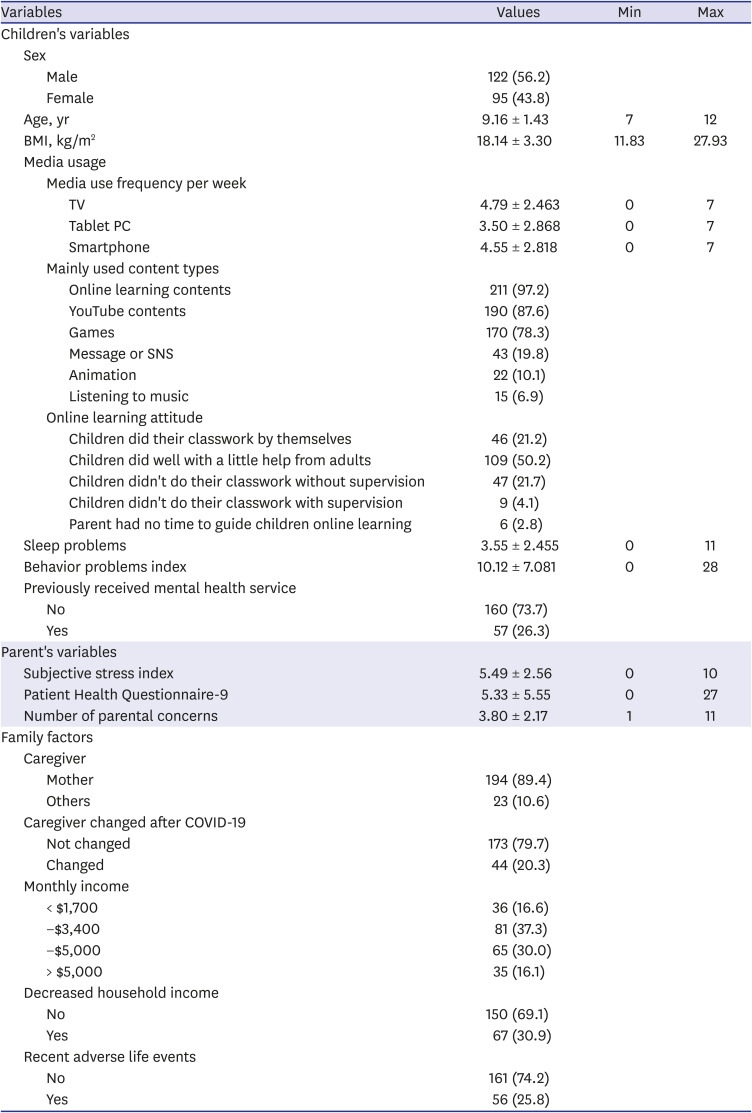3. Chang HY, Park EJ, Yoo HJ, Lee J, Shin Y. Electronic media exposure and use among toddlers. Psychiatry Investig. 2018; 15(6):568–573.

4. Lee DY, Roh HW, Kim SJ, Park EJ, Yoo H, Suh S, et al. Trends in digital media use in Korean preschool children. J Korean Med Sci. 2019; 34(41):e263. PMID:
31650718.

5. Kim B, Han SR, Park EJ, Yoo H, Suh S, Shin Y. The relationship between mother's smartphone addiction and children's smartphone usage. Psychiatry Investig. 2021; 18(2):126–131.

6. Cohen J, Kupferschmidt K. Countries test tactics in ‘war’ against COVID-19. Science. 2020; 367(6484):1287–1288. PMID:
32193299.

7. Van Lancker W, Parolin Z. COVID-19, school closures, and child poverty: a social crisis in the making. Lancet Public Health. 2020; 5(5):e243–4. PMID:
32275858.

8. North CS. Disaster mental health epidemiology: methodological review and interpretation of research findings. Psychiatry. 2016; 79(2):130–146. PMID:
27724836.

9. Lee HJ, Ju YJ, Park EC. Utilization of professional mental health services according to recognition rate of mental health centers. Psychiatry Res. 2017; 250:204–209. PMID:
28167434.

10. Hsiang S, Allen D, Annan-Phan S, Bell K, Bolliger I, Chong T, et al. The effect of large-scale anti-contagion policies on the COVID-19 pandemic. Nature. 2020; 584(7820):262–267. PMID:
32512578.

11. Lee DY, Roh HW, Kim SJ, Park EJ, Yoo H, Suh S, et al. Trends in digital media use in Korean preschool children. J Korean Med Sci. 2019; 34(41):e263. PMID:
31650718.

12. Owens JA, Spirito A, McGuinn M. The Children's Sleep Habits Questionnaire (CSHQ): psychometric properties of a survey instrument for school-aged children. Sleep. 2000; 23(8):1043–1051. PMID:
11145319.

13. Zill N, Peterson JL. Behavior Problems Index. Washington, D.C., USA: Child Trends;1986.
14. Cooksey EC. Consequences of young mothers' marital histories for children's cognitive development. J Marriage Fam. 1997; 59(2):245.

15. Kroenke K, Spitzer RL, Williams JB. The PHQ-9: validity of a brief depression severity measure. J Gen Intern Med. 2001; 16(9):606–613. PMID:
11556941.
16. Russell BS, Hutchison M, Tambling R, Tomkunas AJ, Horton AL. Initial challenges of caregiving during COVID-19: caregiver burden, mental health, and the parent-child relationship. Child Psychiatry Hum Dev. 2020; 51(5):671–682. PMID:
32749568.

17. Kang HM, Jeong DC, Suh BK, Ahn MB. The impact of the coronavirus disease-2019 pandemic on childhood obesity and vitamin D status. J Korean Med Sci. 2021; 36(3):e21. PMID:
33463095.

18. Park CL, Russell BS, Fendrich M, Finkelstein-Fox L, Hutchison M, Becker J. Americans' COVID-19 stress, coping, and adherence to CDC guidelines. J Gen Intern Med. 2020; 35(8):2296–2303. PMID:
32472486.

19. Cluver L, Lachman JM, Sherr L, Wessels I, Krug E, Rakotomalala S, et al. Parenting in a time of COVID-19. Lancet. 2020; 395(10231):e64. PMID:
32220657.

20. Katz LF, Gottman JM. Spillover effects of marital conflict: in search of parenting and coparenting mechanisms. New Dir Child Dev. 1996; 1996(74):57–76.

21. Martinez-Marcos M, De la Cuesta-Benjumea C. Women's self-management of chronic illnesses in the context of caregiving: a grounded theory study. J Clin Nurs. 2015; 24(11-12):1557–1566. PMID:
25524019.

22. Park S, Chang HY, Park EJ, Yoo H, Jo W, Kim SJ, et al. Maternal depression and children's screen overuse. J Korean Med Sci. 2018; 33(34):e219. PMID:
30127707.

23. Frasquilho D, Matos MG, Salonna F, Guerreiro D, Storti CC, Gaspar T, et al. Mental health outcomes in times of economic recession: a systematic literature review. BMC Public Health. 2016; 16:115. PMID:
26847554.

24. Kiernan FM. Income loss and the mental health of young mothers: evidence from the recession in Ireland. J Ment Health Policy Econ. 2019; 22(4):131–149. PMID:
32060231.
25. Riley AW, Valdez CR, Barrueco S, Mills C, Beardslee W, Sandler I, et al. Development of a family-based program to reduce risk and promote resilience among families affected by maternal depression: theoretical basis and program description. Clin Child Fam Psychol Rev. 2008; 11(1-2):12–29. PMID:
18360775.

26. Rasic D, Hajek T, Alda M, Uher R. Risk of mental illness in offspring of parents with schizophrenia, bipolar disorder, and major depressive disorder: a meta-analysis of family high-risk studies. Schizophr Bull. 2014; 40(1):28–38. PMID:
23960245.

29. Wiederhold BK. Children's screen time during the COVID-19 pandemic: boundaries and etiquette. Cyberpsychol Behav Soc Netw. 2020; 23(6):359–360. PMID:
32437623.

31. Weems CF, Scott BG, Banks DM, Graham RA. Is T.V. traumatic for all youths? The role of preexisting posttraumatic-stress symptoms in the link between disaster coverage and stress. Psychol Sci. 2012; 23(11):1293–1297. PMID:
23070308.

32. Weems CF, Overstreet S. Child and adolescent mental health research in the context of Hurricane Katrina: an ecological needs-based perspective and introduction to the special section. J Clin Child Adolesc Psychol. 2008; 37(3):487–494. PMID:
18645740.

33. Fegert JM, Vitiello B, Plener PL, Clemens V. Challenges and burden of the Coronavirus 2019 (COVID-19) pandemic for child and adolescent mental health: a narrative review to highlight clinical and research needs in the acute phase and the long return to normality. Child Adolesc Psychiatry Ment Health. 2020; 14(1):20. PMID:
32419840.








 PDF
PDF Citation
Citation Print
Print




 XML Download
XML Download